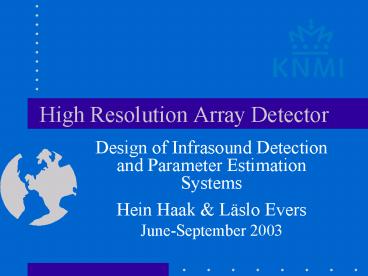High Resolution Array Detector PowerPoint PPT Presentation
1 / 28
Title: High Resolution Array Detector
1
High Resolution Array Detector
- Design of Infrasound Detection and Parameter
Estimation Systems - Hein Haak Läslo Evers
- June-September 2003
2
Design of the Infrasound network
- Bulletin
- Localization
- Association to events
- Parameter estimation
- Signal detection
- Array layout
- Instruments
System design
Bulletin production, build-up, from IMS to IDC
3
Detectors / Estimators
- Several detectors available
- F- detector
- PMCC, MCCM
- PWS phase-weighted stacks
- LTA/STA
- Generally the detailed descriptions of the
detectors could be improved, clear determination
of ROCs could be added, black boxes are
undesirable, transparency is needed - What is the relation between detector and array
design
4
Basic design considerations
- Hardware is hard to adjust, software is more
flexible - Frequency wave number analysis is the standard
- High resolution methods (Capon) are less robust
at low S/N - Coherency detectors are used Fisher,
correlation, semblance throughout the network of
arrays - Small arrays, higher resolution, lower costs
- Detection without some parameter extraction or
estimation is meaningless
5
What is Performance
- Low missed event and false alarm rates (detection
part of the problem) - Event parameters with small error bars
(estimation part of the problem) - Low investment and operation costs leading to
small dimensions of the array (cost efficiency)
6
(No Transcript)
7
Practical array design (1)
- Suppose an array of 8 elements is confined to a
100 ? 100 grid, then the system has 2.5 10 27
independent realizations - A year contains 31.5 10 9 milliseconds
- Brute force array design is not realistic
- Even with only 50 independent positions there are
536,878,650 possible configurations - Alternative solutions are needed like genetic
algorithms or Monte Carlo techniques - Only an approximate solution are possible
- Symmetric approaches are generally not helpful
8
Practical array design (2)
- If most of the array is fixed, for instance
because of infrastructural circumstances
additional elements can be placed strategically,
to achieve a secondary optimum - With isotropic response
- Angular resolution conform array diameter
- Low side lobe amplitudes
9
Side lobes reducers
Side lobes can be reduced through
Hardware
- Small diameter of the array
- Many array elements
- Optimal array design in detail
Software
- Broad frequency band in analysis
- Use of Fisher statistics
Conclusion side lobes should not be a problem
10
Resolution of arrays theory
- Consider Cramér-Rao Lower Bound
- Separation of a signal/noise component and array
geometry - Maximize moment of inertia
- Isotropic condition
- Resolution
- Leads to circular arrays with constant radii, the
central element is not contributing to the
resolution - In sparse arrays non-max-R elements contribute to
lower side lobes
11
- Main lobe / side lobe
- amplitude vs.
- number of elements
- S-range 0.005 sec/m
- and 0.0075 sec/m
- Resolution conform
- diameter of 1200 m
- The product
- Smax?B ? Const.
12
(No Transcript)
13
Array response 8 elements at 1 s period
14
Array response 8 elements at 4 s period
15
(No Transcript)
16
Array response 8 elements at 1 s period with side
lobe penalty function
17
Array response 8 elements at 4 s period with side
lobe penalty function
18
F
- Calculation of the F-statistic from multiple
time series Xct
19
F
- F in terms of coherent signal-to-noise power
ratio
- Power is defined as the square of the amplitude
20
F
- Calculation of the F-response
- FKResp. is the normalized FK-array response
21
F
- Side lobe suppression if any measured F-value is
larger than Fside lobe then it is originating
from the main lobe
For R 2.0, Fside lobe ? 7 with C 8
22
Pentagonal array six elements
- Relative small array in CTBT context
- Radius 100 m
- Small side lobes
- S/N-power ratio 5.5
- 3 Hz, ? ? 110 m
23
F-K and F-plot, S/ Np 5.5, 3 Hz
24
FK and F-plot, S/ Np 0.2, 3 Hz
25
F-K, F-plot, 1/f, S/ Np 5.5, 1 Hz
26
F-K, F plot, 1/f, S/ Np 0.2, 1 Hz
27
Resolution with F- estimator
This plot is made for white, Gaussian noise
28
A New CTBT Infrasound Array?
- Smaller array diameter
- More array elements
- Optimal detailed design
- Better adjusted to the detector
?

